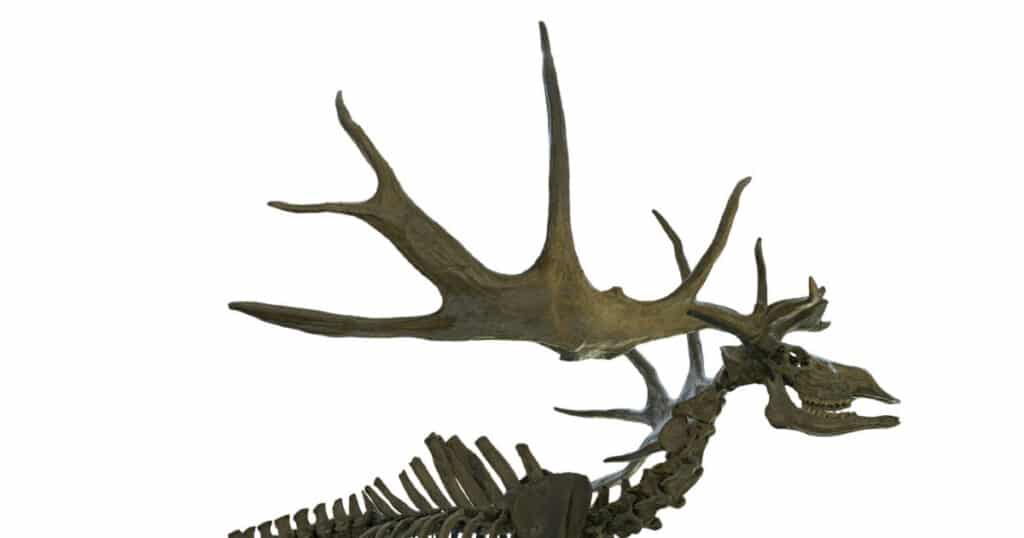Known worldwide for their incredible antlers, Irish elk are an extinct species that still holds a lot of fame because of their incredible size and beauty. With fossilized remains discovered in the 1600s, Irish elk became a very popular topic of study for historians and ecologists.
Irish elk remains were found in Ireland preserved in bogs, and they are believed to have gone extinct during the younger dryas event between 12,000-13,000 years ago. They were thought to have lived across Europe with herds traveling as far east as Siberia.
Despite being gone for such a long time, there is a huge interest in Irish elk. In museums around the world, their skeletal remains have been on display for centuries. With antlers that could span more than 3 meters in width, they are often compared to moose as a comparison of size.
What Is An Irish Elk?
As the third biggest deer species to ever exist, the Irish elk was a large and imposing herbivore that roamed the lands of Europe for hundreds of thousands of years.
They had huge antlers, sometimes spanning incredible widths, that were used to attract females.
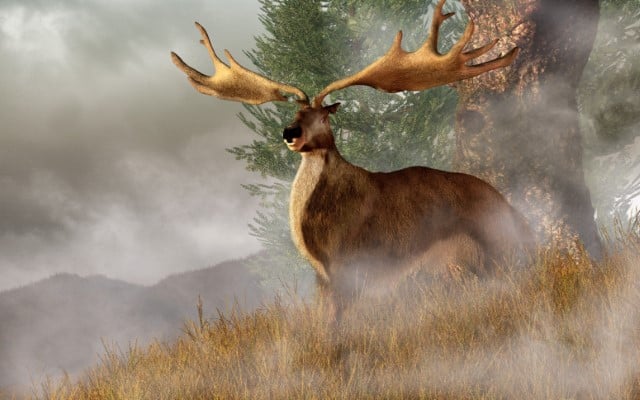
Known otherwise as Megaloceros giganteus, the Irish elk was a member of the family Cervidae, which is tied to a lot of the modern species of deer we know today. Distinctively in the subfamily of old-world deer, the Irish elk existed in a very different world to what we know today.
With the oldest fossils dating to around 400,000 years ago, this species of deer was likely to have coexisted alongside humans for most of our history.
Our earliest record of interaction with these giant beasts dates to around 20,000 years ago, with cave paintings found in the south of modern France. The paintings depict the deer and their distinctive antlers, showing us that humans had seen them and were fascinated by their size.
Not only are the antlers now found in a lot of old Irish buildings and pubs, but it’s also been noted that King Charles II of England owns a pair of antlers that are mounted in the Hampton Court Palace.
To view a modern display, you can visit the Smithsonian Museum of natural history, which features a full skeleton setup that gives you an idea of the size and appearance of this species.
Even today, this exhibit is one of the most popular within the museum and offers incredible insight into why we were so fascinated by these creatures.
There is a lot of speculation as to why the Irish elk went extinct, and while we can’t know for sure why they all died out, professionals can speculate the likeliest reasons.
Why Did The Irish Elk Go Extinct?
It is speculated that habitat loss was one of the biggest drivers of the extinction of Irish elk, with the younger dryas event causing a severe cooling of the planet.
During this time, the Irish elk’s natural habitat deteriorated rapidly, causing them to struggle for food and resources.
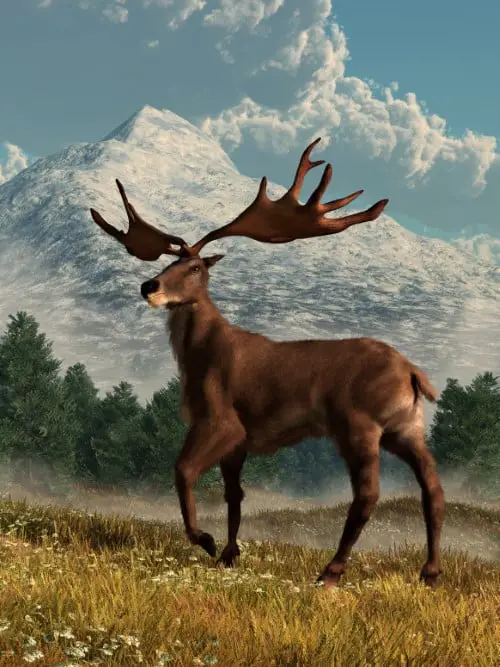
One of the biggest challenges posed by the rapid cooling of the younger dryas event was that plant growth was incredibly slow. This would have had a huge impact on the ability of Irish elk to forage, with them being unable to find enough food during this period.
Irish elk required a very large amount of calorie intake to be able to survive, and with the younger dryas event dramatically reducing the amount of food available, they would eventually starve.
On top of their food source deteriorating, humans would have been actively hunting the remainder of the population to the point where they were unable to repopulate their numbers.
It’s thought that without enough food and a lack of protection from human hunters, Irish elk gradually declined in population until there were no more.
Some professionals believe the weight of their antlers could have also factored into the extinction, which may have been why so many have been found drowned in bogs.
During deep snow, the bogs were covered by a blanket layer that may have deceived the Irish elk, causing them to sink.
Despite their size, the pressures of the natural environment and human hunters were too much for them to overcome, and gradually, the species became extinct. Their fossilized skeletons and bodies can be found in a lot of European countries, with a bigger concentration in Ireland.
Where Were Irish Elk Found?
During the time in which Irish elk were alive, the landscapes looked very different from how they did today. In their earliest period, the continents were connected by passages that are now underwater.
Despite their name, Irish elk were found across a wide area within Eurasia. The geography back in these times allowed for the Irish elk and other species of giant deer to migrate vast distances to find food.
The conditions of the bogs in Ireland may have been the main reason why so many of these elk were associated with the area, as the anaerobic conditions of bogs preserve organic matter.
The wet conditions of bogs also meant it was easy for the elk to become trapped and unable to escape, leading them to drown and be preserved in a state which is still seen today centuries later.
It is now understood that Irish elk have been found as far east as Siberia, which means they must have had very large migrations across the land.
The areas in which these elk were found would have been very susceptible to rapid drops in temperatures due to snowfall covering new growth.
Although these giant animals died out thousands of years ago, there are still a lot of modern deer that resemble the Irish elk in appearance. Many of them are smaller and less impressive, but they are still closely related and appear to be very similar.
What Is The Closest Living Relative To The Irish Elk?
Discovering where the lineage of Irish elk could be today is a matter of tracing back to their most common ancestor.
DNA that is used to trace the Irish elk’s ancestry can be found in fossilized tissues from specimens that died around 7,000 years ago.
Although it is called an Irish elk, it is actually a very large deer and is distinctive from the new world deer subfamily. Because the old-world deer is part of a much older heritage, the bloodline goes back a long way before splitting to create the deer we know today.
With a 90% match in DNA, the Irish elk has been traced back to find its closest relative about 4 to 5 million years ago. The fallow deer is now the closest match we have to one of these incredible giants, and the flat antlers are one of a few features they still share.
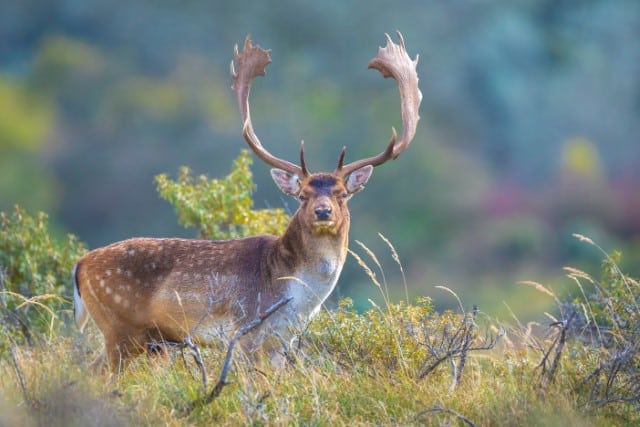
The fallow deer is native to Europe but can now be found in many places around the world.
It has adapted over time to deal with harsher climates, and although they are not as large as Irish elk, they are still a very impressive deer species and have been around for thousands of years.
It may have been because of this robust difference in the genealogy that fallow deer were able to survive and thrive while the Irish elk declined.
The species was very big, but getting a frame of reference relative to modern deer species you may recognize can offer an appreciation for the size of this incredible giant.
How Big Was The Irish Elk?
One of the best ways to put the size of the Irish elk into perspective is by comparing it to some deer we have today.
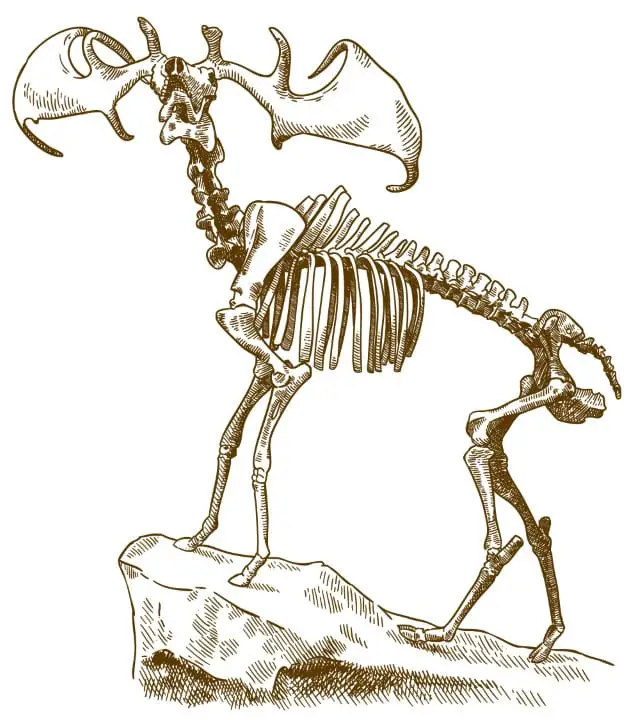
Moose are the biggest species on the planet that are considered part of the deer family and are a great way to put the size of the Irish elk into perspective.
How Did Irish Elk Compare To Modern Moose?
Moose are now one of the biggest animals in the deer family and are the largest species alive today. Usually, males can range between 1,000 and 1,150 pounds on average, and females weigh around 900 pounds.
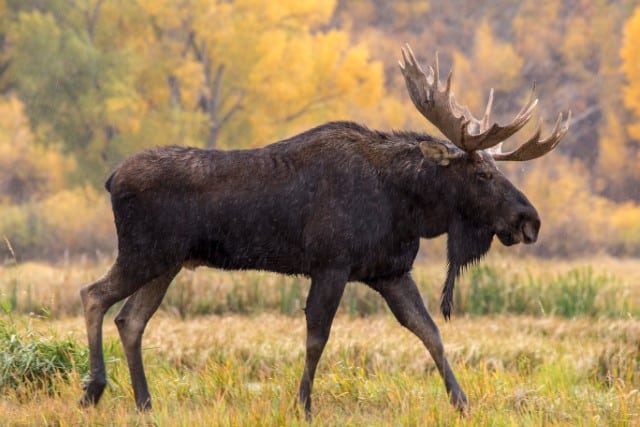
Irish elk were very similar in weight, with an average weight in males of 1300 pounds, exceeding the average for moose. Because Irish elk were also a bit thinner compared to moose, they appeared much larger proportionally.
When it comes to height, the average Irish elk has the same maximum height as a moose, with a height of 2.1m tall. With the build of their antlers, there is no doubt that seeing an Irish elk in the wild would have been a bewildering experience, similar to seeing a moose today.
As mentioned before, the antlers of Irish elk were twice the width of a modern moose’s antlers which would have added to their intimidating aura.
To this day, Irish elk are the third largest species of deer to have been discovered, and it’s interesting to see how their modern relatives live in the wild.
How Did Irish Elk Compare To Fallow Deer
As the modern relative that exists in today’s world, the fallow deer is a really interesting comparison to put up against the Irish elk. Although their most recent ancestor existed almost 4-5 million years ago, the evolutionary arc of fallow dear isn’t too far from the Irish elk.
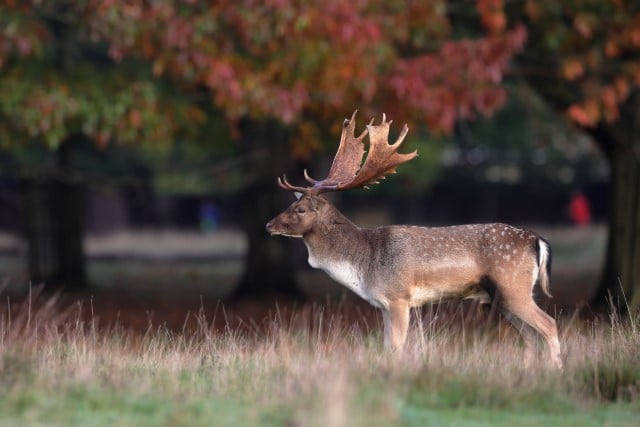
When it comes to the size difference, there is a very obvious difference in both the overall size of the fallow deer and their antler width.
One of the biggest differences between Irish elk and fallow deer is that the fallow deer have much smaller antlers. The antlers of a fallow deer only measure, on average, about 70 cm in width, which is about 20% of the size of the antlers of an Irish Elk.
As a relatively small deer, the fallow deer is often found to be around 90cm tall, which is just over half the average height of modern humans.
With the size of fallow deer being drastically smaller than their ancient relatives, it can be hard to imagine that they are related to Irish elk.
This is the main reason that Irish elk have their name, as the first people who discovered it ended up thinking it was an elk because of its antler size and also due to the abundance of actual elk species discovered in Ireland at the time.
There were plenty of big deer during the same time period in which the Irish elk existed, which would have made it a very interesting time to be alive. It’s hard to overstate just how incredible it must have been to see an Irish elk up close.
Other Big Deer That Lived Around The Same Time
The Pleistocene was a time period in which Irish elk roamed in huge numbers. While the Pleistocene was a very broad time period ranging from 1.8 million years ago until about 10,000 years ago, the Irish elk was found for a majority of the era with no shortage of numbers.
At the same time as the Irish elk, a lot of other species of huge deer roamed the earth. While the Irish elk was one of the heaviest of the old-world deer, it was rivaled in size by two very distinguished members of the deer family.
Cervalces Latifrons
The broad-fronted moose was a very large deer that coexisted with the Irish elk during the Pleistocene era. Just like the Irish elk, it preferred open grasslands and thrived in the tundra and steppes, feeding off of vegetation.
Much larger than any modern moose, this was a huge member of the deer family that resided in North America and co-existed with saber-toothed cats, long-horned bison, and mammoths.
As an ancestor to modern moose, this was a huge beast that weighed up to 2,600 pounds which is an incredible amount of weight for a member of the deer family. Some of the largest specimens found to date were up to 2.6 meters tall, and their antlers spanned 2.5 meters wide.
Despite weighing up to twice as much as an Irish elk, the broad-fronted moose is not as well-known to the public, which may be due to their antlers which are slightly smaller and may be seen as less impressive.
The antlers of Cervalces latifrons were very similar to modern moose, which became the species that overtook their predecessor towards the end of the most recent ice age.
The broad-fronted moose is believed to have migrated to North America during the middle of the Pleistocene era, which is where their descendants, the Cervalces Scotti, were found and evolved alongside the modern moose which we know today.
Cervalces Scotti
The Cervalces Scotti, also known as the stag-moose, was a very large member of the deer family that existed more recently alongside the Irish elk. Despite being closely related to modern moose, the stag moose more closely resembled a deer, especially with the shape of its muzzle.
Similar to their ancestor Cervalces Latifrons, the stag moose was found in spruce parkland areas alongside other herbivorous megafauna. They likely fed off of vegetation that surrounded water sources, as they were usually found near lakes or rivers.
The stag moose was much larger than your typical deer and weighed up to 1,500 pounds. While this is a very close weight to the Irish elk, the stag moose was a lot taller, standing up to 2.5 meters at the shoulder.
The main reason that this species went extinct has been speculated to be a result of the competition from modern moose that were driven into the habitat of Cervalces Scotti as a result of glacial retreats.
It’s also possible that the change in landscape and habitat from spruce parklands to new grassland ecosystems was also a factor in the decline and extinction of this species.
Fossil discoveries have pinned this species to have lived as recently as 13,500 years ago, which correlates to about the same period of time in which the Irish elk started seeing a rapid decline in populations.
While both the broad-fronted moose and the stag moose were much larger than their modern relatives, they didn’t hold a candle to the intimidation factor that the Irish elk held as a result of their antlers.
Just How Big Were the Irish Elk’s Antlers?
The incredible width of the Irish elk’s antlers is one of the distinguishing factors, and still, to this day, they are very impressive to behold.
The largest of Irish elk antlers measure up to 3.5 meters in width which is almost double that of moose antlers which are around 1.5 meters wide.
Experts on Irish elk have stated that the giant antlers served no other purpose than to impress the female elk. Males would likely compete similarly to other species of deer, which involved clashing antlers and proving their strength.
The Irish elk’s giant antlers were also likely at a huge disadvantage as they could get caught up in branches or bushes when they were running, entangling them and putting them at risk of being attacked.
Existing most recently at around 8,000 years ago in what is now Russia, the landscape rapidly grew into thick forests where their large antlers were more of a hindrance rather than an asset.
Despite this, the Irish elk’s giant antlers will forever be remembered, and to this day still impress us when we look at them. Whilst they may have played a role in their extinction, the beauty of these animals cannot be understated.
The diet is another interesting topic of research amongst Irish elk enthusiasts, and a lot of modern experts can take an educated guess as to what these giant creatures ate to get through the day.
What Would Have Been The Preferred Diet Of Irish Elk?
Irish elk were herbivorous and were able to consume a variety of vegetation. While it is very difficult to know exactly what their diet consists of, experts can take an educated guess based on the environment they live in.
Irish elk were found in open grasslands that contained a wide variety of vegetation that the elk could feed off. It is most likely that they were found around areas surrounding water which allowed for growth that contained the rich nutrients they needed to grow.
Existing for a very long time before their decline, it is likely that Irish elk adapted alongside the change in habitat that went from spruce parklands to open grassland ecosystems.
While this change would have put pressure on the population of Irish elk, they endured for many thousands of years after the spruce parklands disappeared.
Habitats changed significantly over the Pleistocene era, with a lot of the ice sheets and glaciers retreating from increasing global heat.
About 12,000 years ago, this would have placed the most pressure on the species, which is why we see such a rapid decline in their population around this time period.
With the most recently dated remains to be from around 8,000 years ago, it is a testament to their durability that some small pockets of their species survived until a likely extinction as a result of hunting from humans on top of their already decreasing food sources.
With such a huge size and antlers that required a lot of nutrition, their diet would have been varied and plentiful to sustain them through the changing environments they found themselves in.
Grasses, shrubs, and new growth would have been a popular choice, along with some plant tubers, roots, and aquatic plants. It is likely that they seasonally foraged more so when food sources were at their peak, as this would have been the most efficient way to feed their large bodies.
The Irish elk’s adaptation and survival for so long is a testament to its ability to survive in extreme environments. Unfortunately, due to the changing landscape and hunting of humans, they simply couldn’t endure into the modern age.
As one of the most famous extinct species, we will always be in awe of the Irish elk and their giant antlers, which are still impressive today.
We may never know all of the details surrounding their extinction, but it can still be argued that they were one of the most impressive creatures to ever roam the earth.

